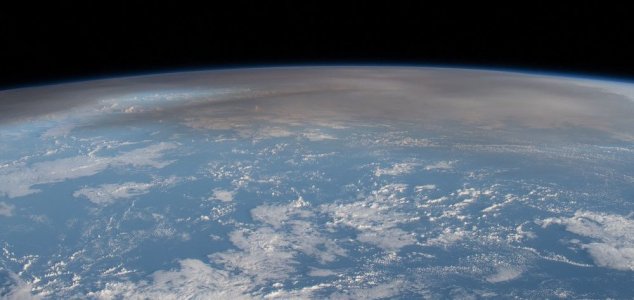Science & Technology
May 15, 2022 · 2 comments
2 comments

The atmospheric plume could be seen from space. Image Credit: NASA / Kayla Barron
The Krakatoa eruption, for instance, which took place in 1883, most likely rivalled or exceeded the size of the atmospheric disturbance produced by the Tonga eruption but was many times more deadly, resulting in the deaths of more than 30,000 people.
Even so, the effects of the Tonga eruption were felt around the world and the atmospheric explosion was so significant that it has since been confirmed to be the biggest ever recorded by modern instruments.
"Tonga was a truly global event, just as Krakatau was, but we've now got all these geophysical observation systems and they recorded something that was really unprecedented in the modern data," said study lead author Dr Robin Matoza from the University of California, Santa Barbara.
16,500km away in the UK, the effects were picked up around 14 hours after the event itself.
"At the time, we had a laser cloud-base recorder looking at the cloud base and as the wave went through the cloud was perturbed," said atmospheric physicist Prof Giles Harrison.
"If ever you wanted evidence that the atmosphere is a remarkably interconnected thing, this was it. And what happens on one side of the planet can propagate around to the other side at the speed of sound."
Source: BBC News | Comments (2)
Tonga eruption was largest modern atmospheric explosion
By T.K. RandallMay 15, 2022 ·
 2 comments
2 comments
The atmospheric plume could be seen from space. Image Credit: NASA / Kayla Barron
The eruption, which occurred in January, was larger than any other eruption or atomic bomb detonation in the last 100 years.
Given the force of the explosion and the fact that it produced a series of deadly tsunamis, the eruption of the underwater volcano Hunga Tonga-Hunga Ha'apai, which reached its climax on January 15th, resulted in surprisingly few deaths compared to other similar events in the past.The Krakatoa eruption, for instance, which took place in 1883, most likely rivalled or exceeded the size of the atmospheric disturbance produced by the Tonga eruption but was many times more deadly, resulting in the deaths of more than 30,000 people.
Even so, the effects of the Tonga eruption were felt around the world and the atmospheric explosion was so significant that it has since been confirmed to be the biggest ever recorded by modern instruments.
"Tonga was a truly global event, just as Krakatau was, but we've now got all these geophysical observation systems and they recorded something that was really unprecedented in the modern data," said study lead author Dr Robin Matoza from the University of California, Santa Barbara.
"At the time, we had a laser cloud-base recorder looking at the cloud base and as the wave went through the cloud was perturbed," said atmospheric physicist Prof Giles Harrison.
"If ever you wanted evidence that the atmosphere is a remarkably interconnected thing, this was it. And what happens on one side of the planet can propagate around to the other side at the speed of sound."
Source: BBC News | Comments (2)

The Unexplained Mysteries
Book of Weird News
AVAILABLE NOW
Take a walk on the weird side with this compilation of some of the weirdest stories ever to grace the pages of a newspaper.
Click here to learn more

Support us on Patreon
BONUS CONTENTFor less than the cost of a cup of coffee, you can gain access to a wide range of exclusive perks including our popular 'Lost Ghost Stories' series.
Click here to learn more
United States and the Americas
UK and Europe
Science and Technology
Palaeontology, Archaeology and History
Total Posts: 7,749,991 Topics: 323,891 Members: 203,495
Not a member yet ? Click here to join - registration is free and only takes a moment!
Not a member yet ? Click here to join - registration is free and only takes a moment!






























Please Login or Register to post a comment.